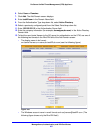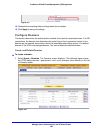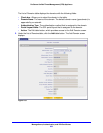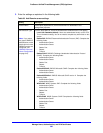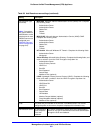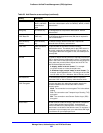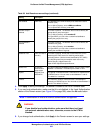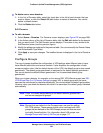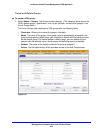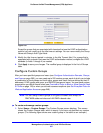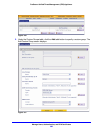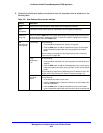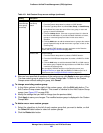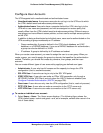
Manage Users, Authentication, and VPN Certificates
394
ProSecure Unified Threat Management (UTM) Appliance
To delete one or more domains:
1. In the List of Domains table, select the check box to the left of each domain that you
want to delete, or click the Select All table button to select all domains. You cannot
delete a default domain.
2. Click the Delete table button.
Edit Domains
To edit a domain:
1. Select Users > Domains. The Domains screen displays (see Figure 232 on page 388).
2. In the Action column of the List of Domains table, click the Edit table button for the domain
that you want to edit. The Edit Domains screen displays. This screen is very similar to the
Add Domains screen (see the previous figure).
3. Modify the settings as explained in the previous table. (You cannot modify the Domain Name
and Authentication Type fields.)
4. Click Apply to save your changes. The modified domain is displayed in the List of Domains
table.
Configure Groups
The use of groups simplifies the configuration of VPN policies when different sets of users
have different restrictions and access controls. It also simplifies the configuration of web
access exception rules. Like the default domain of the UTM, the default group is also named
geardomain. The default group geardomain is assigned to the default domain geardomain.
You cannot delete the default domain geardomain, nor its associated default group
geardomain.
When you create a domain, for example, on the second SSL VPN Wizard screen (see SSL
VPN Wizard Step 2 of 6 (Domain Settings) on page 342), a default group with the same
name as the new domain is created automatically. You cannot delete this default group either.
However, when you delete the domain with which it is associated, the default group is deleted
automatically.
Note: IPSec VPN users always belong to the default domain (geardomain)
and are not assigned to groups.
Note: Groups that are defined on the Groups screen are used for setting
SSL VPN policies. These groups should not be confused with LAN
groups that are defined on the LAN Groups screen and that are used
to simplify firewall policies. For information about LAN groups, see
Manage Groups and Hosts (LAN Groups) on page 111.




